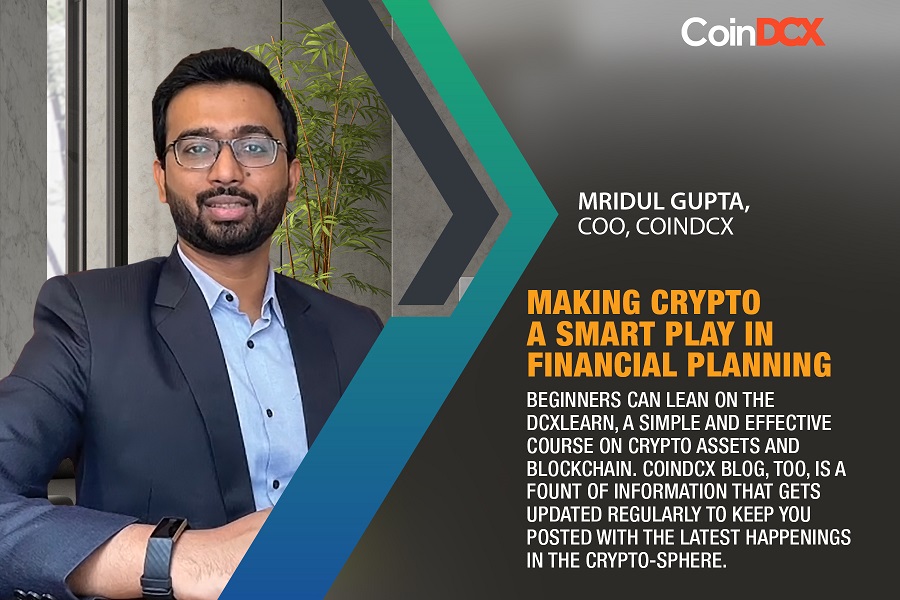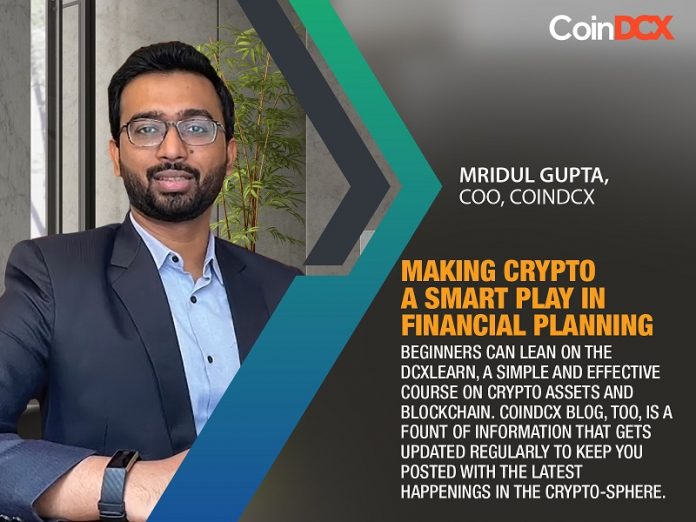Millions of investors are turning to virtual assets as a means to diversify their investment portfolio. How can one make the most of this newish asset class?
By Brand Connect
 Despite all its volatility, Bitcoin, the world’s oldest crypto asset was declared as the best performing asset class of the decade until last year. Its returns were more than all other investment instruments and ten times higher than those of Nasdaq 100. Again in 2020-21 alone, it was crowned as the top asset class with returns of over 800%. It is equally true that prices of Bitcoin and other virtual assets are subject to wild gyrations across different time periods. But unlike say, a mutual fund or a share which is easy to grasp conceptually, what is a crypto asset and why is it different?
Despite all its volatility, Bitcoin, the world’s oldest crypto asset was declared as the best performing asset class of the decade until last year. Its returns were more than all other investment instruments and ten times higher than those of Nasdaq 100. Again in 2020-21 alone, it was crowned as the top asset class with returns of over 800%. It is equally true that prices of Bitcoin and other virtual assets are subject to wild gyrations across different time periods. But unlike say, a mutual fund or a share which is easy to grasp conceptually, what is a crypto asset and why is it different?
Unlike traditional currencies, crypto assets are not controlled by any central bank or any centralised authority. The concept is underpinned by a peer-to-peer computer network made up of tens of thousands of people around the world. The whole idea is that no central figure would be able to manipulate the prices or tamper with what is stored on the blockchain, the underlying technology that tracks all crypto transactions. Since 2009 when Bitcoin was first mined by its enigmatic founder, Satoshi Nakamoto, thousands of digital assets are in circulation today.
Could crypto assets be considered as an investment option?
There are lots of views on the subject and almost everyone has an opinion on it. Those who are convinced of the future potential of the technology, swear by it. Others consider it to be a passing trend. Many will also point to the fact that prices of most virtual assets have plummeted in the recent past when compared to their all-time highs last year. Should this then be a good time to buy and wait for the prices to rise in the long term?
First, make your own decision:
It is easy to be swayed by what colleagues, friends and financial advisors might suggest. There is also a fear of missing out and the tendency to follow the herd. It would be best not to fall in any trap. Instead of following pure instincts, such decisions are best made after due diligence and research.
But where do I get started?
The Internet is awash with content touting crypto assets and crypto investment. It is easy to get lost in the clutter. Before starting the investment journey, it is important to choose the right source of information. Paid courses on Udemy and Coursera can be a good start if you would like to deep-dive.
Beginners can learn on the DCXLearn, a simple and effective course on crypto assets and blockchain. CoinDCX Blog, too, is a fount of information that gets updated regularly to keep you posted with the latest happenings in the crypto-sphere. For instance, among the latest posts include details about the recent regulation of Tax Deducted at Source (TDS) of 1% for all crypto transactions in the country. Another article on CoinDCX ‘Earn’ explains the methodology of gaining passive income on crypto investments.
What should be the investment amount?
There’s only one person who can have an answer to this question and that is you, the investor. A common refrain among the experts is that you shouldn’t invest more than what you are willing to lose. For all the vaunted prowess of the cryptosphere, it is still in its infancy when compared to other established asset classes like gold, stocks and mutual funds. And yet according to publications like The Economist, “it is wise to add bitcoin to an investment portfolio” as an “excellent source of potential diversification”.
Set SMART goals
Whether it is the matter of our personal targets (say, losing weight) or professional ones (becoming a CXO), it helps if these goals are SMART, an acronym that stands for Specific, Measurable, Actionable, Realistic and Time-based. Investing in Crypto is no different. Review your investments periodically with a SMART lens without bias.
Start small
In stock markets, one cannot buy a small portion of a share. For instance, if the share price of a company is Rs. 6,000, one cannot have a small pie of it. However, one of the merits of the cryptosphere is that it allows you to buy even 100 rupees of an asset which can be invested even for the long run. This can also be set up on an auto-pilot mode in the mould of systematic investment plans for mutual funds.
CoinDCX has a Crypto Investment Plan that encourages savings at regular intervals. Such an option eliminates the risk of delayed decision-making. Small amounts can be invested on a weekly basis without having to keep a constant tab of the market.
Rupee cost averaging strategy
The Crypto Investment Plan also ensures that irrespective of the price of the asset, a fixed amount is invested at regular intervals. During price falls, more units of the same asset are automatically purchased which can be redeemed in the future at a higher rate when the prices soar. Similarly, since the amount of investment is fixed, fewer units are purchased when the prices are high. The law of averages kick in.
Lastly find the right crypto exchange
While choosing the right crypto exchange platform, do not look for the best rates but invest in a platform that you trust. Hard-earned savings need a safe haven. CoinDCX, an extensive marketplace of over 200 coins and 500 markets, is among the best and biggest exchanges in the world.
In addition to impenetrable security measures such as cold wallet storage, withdrawal confirmations, and 2-Factor authentication, complete fund safety is ensured by BitGo, a digital asset trust company. CoinDCX is, therefore, a highly trusted exchange with a loyal user base. Get started.
Key Takeaways
The pages slugged ‘Brand Connect’ are equivalent to advertisements and are not written and produced by Forbes India journalists.
Making crypto a smart play in financial planning by Mridul Gupta, COO, Coindcx
1% TDS on crypto in India
Why higher adoption of blockchain is crucial to economic growth
Collective disruption: How today's metaverse is shaping tomorrow's finance
Get clear with crypto with CoinDCX
How central bank digital currencies could impact the digital currency market
A beginner's guide to DeFi
Staking, Swapping, Farming: All you need to know about DeFi concepts
CoinDCX: Unleashing the potential of Crypto in India
Crypto products and NFTs are unregulated and can be highly risky. There may be no regulatory recourse for any loss from such transactions. For any queries, write to [email protected].
Copyright © 2022 Forbes India. All rights reserved.






